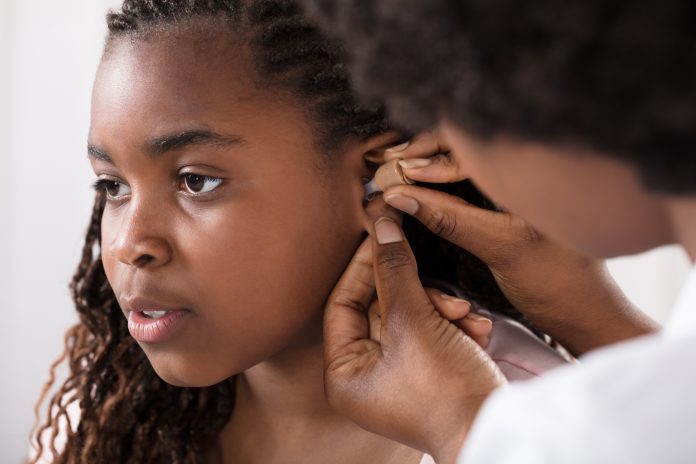Glue ear is a common cause of hearing impairment and disability amongst children. AI can improve the accuracy of diagnosis and cut down annual NHS costs.
Otitis Media with Effusion (OME), commonly known as “Glue Ear” is one of the most common causes of childhood hearing impairment and disability. It is estimated that more than 80% of children will have an episode of otitis media before the age of 10. This high prevalence places a significant cost burden on the NHS with approximately 200,000 children with glue ear seen annually in primary care (Williamson et al., 2006).
Glue ear is one of the biggest challenges for non-ENT/Audiology professionals
The lack of clear infectious symptoms (e.g., earache or fever) and difficulties in assessing the hearing status of young children (particularly as there are no audiology specific diagnostic facilities in the primary care setting), result in only 50% of glue ear cases being correctly diagnosed by paediatricians, in comparison to 73% by otolaryngologists (Pichichero and Poole, 2001). Poor diagnostic accuracy leads to delayed diagnosis and inappropriate intervention decisions, such as re-assurance without appropriate treatment, or referral to ENT unnecessarily by GPs. Consequently, OME is one of the biggest challenges for ENT specialists according to the ENT Elective Care Handbook (2019).
Watchful waiting is an option recommended in the NICE guidelines for the initial clinical management of OME (NICE, 2021). However, limited diagnostic information, particularly in children unable or unwilling to cooperate with tests can leave parents unclear as to the problems caused by OME and can cause them to have unrealistic expectations or even anxiety. Indeed, many parents are upset when told to wait for 3 months (in line with NICE guidance) before any intervention can be considered. Furthermore, delayed diagnosis and poor management can result in severe and persistent OME with surgical treatment becoming the only management option, leading to long waiting times and excessively high costs for the NHS.
AI tools can diagnose OME with an accuracy of 95%
The field of Artificial Intelligence (AI) is rapidly evolving and has already been used to support and improve health services in many areas. A number of studies have shown, for example, that AI provides an effective tool to classify pathological conditions from medical images, which can then support diagnosis and management. AI applications to the field of ENT and Audiology have provided automated tools for the diagnosis of middle ear disorders by analysing clinical data, e.g., otoscopic images and computed tomography scans. Consequently, implementation of AI tools presents possibilities for use in hearing healthcare services as a clinical decision support system.
Clinical decision support (CDS) systems are designed to assist clinicians in their diagnostic decision-making by using the individual patient’s data to arrive at a patient-specific diagnosis or recommended intervention. Our recent research into AI has made great progress in demonstrating its potential for the accurate diagnosis of OME (Grais et al., 2021). This novel research measures energy absorbance of the middle ear at varying frequencies and pressures in normal ears and ears with OME. With this information the AI tools will provide an accurate automated diagnosis which can support the clinician in their decision-making process.
Our results prove the capability of AI tools to diagnose OME automatically with an accuracy of 95%. Implementing the AI-CDS for automated diagnosis in children with OME has the potential to drive evidence-based standardisation of childhood OME diagnosis to improve care delivery and patient outcomes. This work will have significant and direct impact on clinical assessment and diagnostic concepts for OME in professional communities, and thus NICE guidelines for OME treatment.
AI has the potential to improve efficiency and cut down costs
Furthermore, the important research outputs indicate that AI has great potential for the development of a quick, accurate, non-specialist diagnostic tool for the identification and management of childhood OME in the primary care setting and community clinics. As a result, it will provide long-term benefits to the wellbeing of children with glue ear and their families. In the meantime, the accurate, timely, efficient, equitable and patient- centred delivery will improve the capacity of ENT and Audiology services, so that they can provide more efficient and cost-effective services and avoid ‘unnecessary’ referrals. This will also cut down the waiting times for children with OME, and consequently provide economic benefits in terms of reducing service delivery cost.
Overall, the future development of low-cost AI-CDS for automated diagnosis of OME provides solutions to a number of challenges, including the shortage of specialist training and unaffordable equipment. It thereby establishes a cost-effective and sustainable hearing healthcare service model, which could be used globally, particularly in Low-and Middle-Income Countries (LMICs).
Author and funding
Dr Fei Zhao, Reader in Hearing Science, Cardiff School of Sport and Health Sciences, Cardiff Metropolitan University. He has been awarded an Artificial Intelligence in Health and Care Award, through the National Institute for Health Research (NIHR). Dr Zhao also won Global Academies and Santandar 2021 Fellowship Award. This funding enables Dr Zhao to collaborate with a world-leading scholar in this field, Professor De Wet Swanpoel from the University of Pretoria in South Africa. Professor Swanpoel also serves as the scientific advisor of an award winning digital health company, the HearX Group, which specialises in mobile health solutions for ear and hearing care. Further development and implementation of effective and non-specialist AI tools will improve accessibility and quality of global hearing healthcare for children living with hearing impairment.
References
- Grais, E.M., Wang, X.Y., Wang, J., Zhao, F., Jiang, W., Cai, Y.X., Zhang, L.F., Lin, Q.W, Yang, H.D., 2021, Analysing wideband absorbance immittance in normal and ears with otitis media with effusion using machine learning. Scientific Reports, 11:10643. org/10.1038/s41598-021-89588-4.
- Pichichero, M.E. and Poole, M.D., 2001. Assessing diagnostic accuracy and tympanocentesis skills in the management of otitis media. Arch Pediatr Adolesc Med. 155(10):1137-42. https://jamanetwork.com/journals/jamapediatrics/fullarticle/191139.
- Ear-nose-throat-elective-care-handbook, 2019, Transforming elective care services ear, nose and throat (ENT): Learning from the Elective Care Development Collaborative. https://www.england.nhs.uk/wp-content/uploads/2019/04/ear-nose-throat-elective-care-handbook.pdf.
- National Institute for Health and Clinical Excellence (NICE). Otitis media with effusion: Management. London: NICE; Last revised in June 2021. Available:https://cks.nice.org.uk/topics/otitis-media-with-effusion/management/management/
- Williamson, I., Benge, S., Mullee, M., 2006, Consultations for middle ear disease, antibiotic prescribing and risk factors for reattendance: a case-linked cohort study. Br J Gen Pract. 2006;56:170-175.
The development of an Artificial Intelligence system for the automated diagnosis of otitis media with effusion in children. NIHR Artificial Intelligence in Health and Care Award (AI Award 02305).
Please note: This is a commercial profile
© 2019. This work is licensed under CC-BY-NC-ND.








